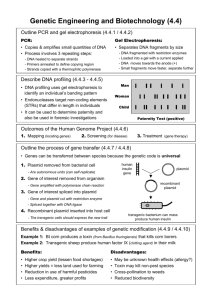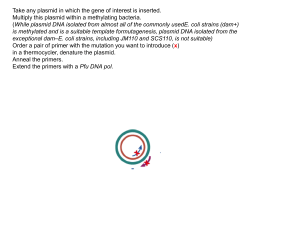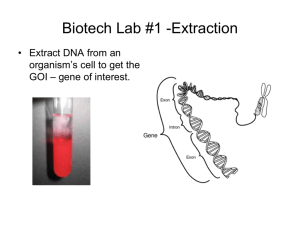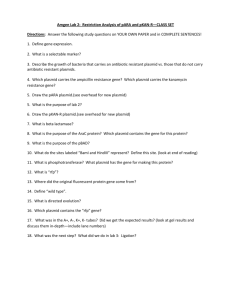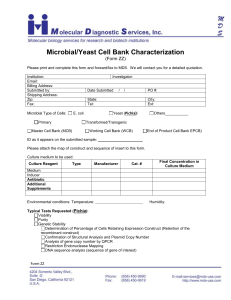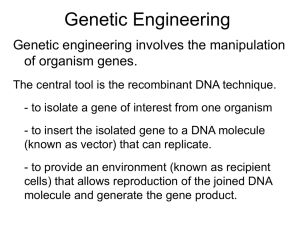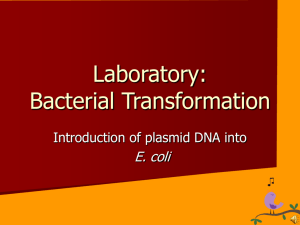Staphylococcus aureus Transport Gene Recombinant Plasmids Timothy S. Gomez
advertisement
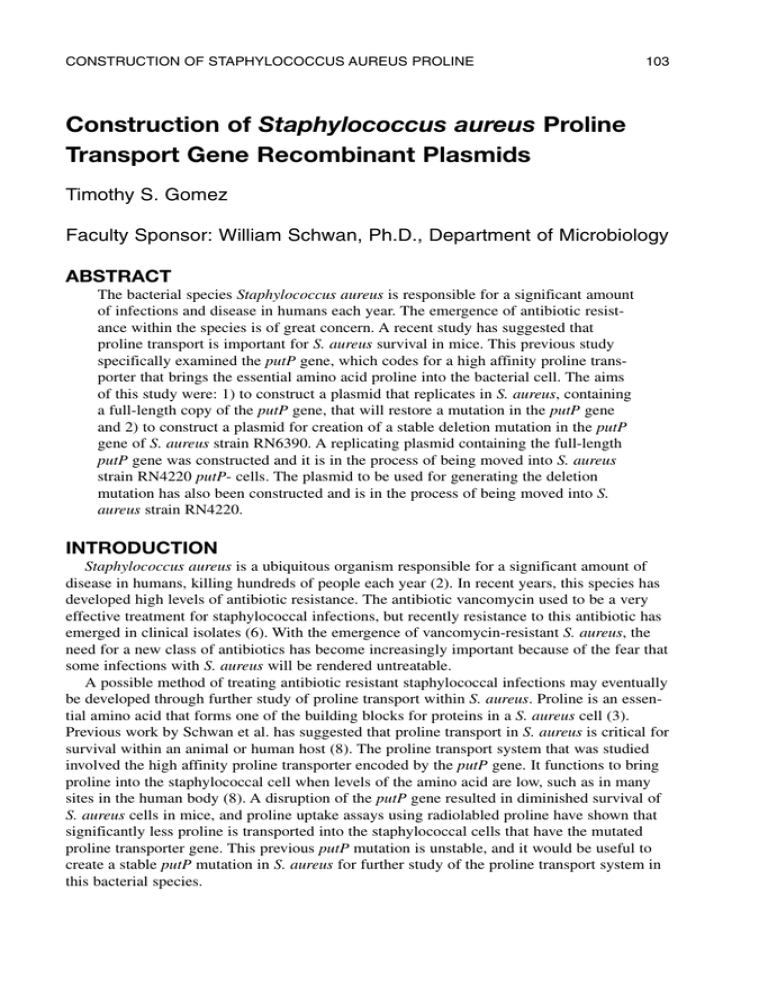
CONSTRUCTION OF STAPHYLOCOCCUS AUREUS PROLINE 103 Construction of Staphylococcus aureus Proline Transport Gene Recombinant Plasmids Timothy S. Gomez Faculty Sponsor: William Schwan, Ph.D., Department of Microbiology ABSTRACT The bacterial species Staphylococcus aureus is responsible for a significant amount of infections and disease in humans each year. The emergence of antibiotic resistance within the species is of great concern. A recent study has suggested that proline transport is important for S. aureus survival in mice. This previous study specifically examined the putP gene, which codes for a high affinity proline transporter that brings the essential amino acid proline into the bacterial cell. The aims of this study were: 1) to construct a plasmid that replicates in S. aureus, containing a full-length copy of the putP gene, that will restore a mutation in the putP gene and 2) to construct a plasmid for creation of a stable deletion mutation in the putP gene of S. aureus strain RN6390. A replicating plasmid containing the full-length putP gene was constructed and it is in the process of being moved into S. aureus strain RN4220 putP- cells. The plasmid to be used for generating the deletion mutation has also been constructed and is in the process of being moved into S. aureus strain RN4220. INTRODUCTION Staphylococcus aureus is a ubiquitous organism responsible for a significant amount of disease in humans, killing hundreds of people each year (2). In recent years, this species has developed high levels of antibiotic resistance. The antibiotic vancomycin used to be a very effective treatment for staphylococcal infections, but recently resistance to this antibiotic has emerged in clinical isolates (6). With the emergence of vancomycin-resistant S. aureus, the need for a new class of antibiotics has become increasingly important because of the fear that some infections with S. aureus will be rendered untreatable. A possible method of treating antibiotic resistant staphylococcal infections may eventually be developed through further study of proline transport within S. aureus. Proline is an essential amino acid that forms one of the building blocks for proteins in a S. aureus cell (3). Previous work by Schwan et al. has suggested that proline transport in S. aureus is critical for survival within an animal or human host (8). The proline transport system that was studied involved the high affinity proline transporter encoded by the putP gene. It functions to bring proline into the staphylococcal cell when levels of the amino acid are low, such as in many sites in the human body (8). A disruption of the putP gene resulted in diminished survival of S. aureus cells in mice, and proline uptake assays using radiolabled proline have shown that significantly less proline is transported into the staphylococcal cells that have the mutated proline transporter gene. This previous putP mutation is unstable, and it would be useful to create a stable putP mutation in S. aureus for further study of the proline transport system in this bacterial species. 104 GOMEZ The purpose of this research was to construct a plasmid that can be used to create a stable deletion mutation in the putP gene of S. aureus and to construct a second plasmid that can be used for complementation of a putP mutation in S. aureus (i.e. restoration of the putP gene). This was achieved through recombinant DNA technology, cloning, and the polymerase chain reaction. The plasmids have been constructed in E. coli strains. It is hoped that the complementing plasmid will eventually be moved into S. aureus RN6390, a virulent strain (8). Currently, this plasmid has been successfully transferred into S. aureus strain RN4220 for preliminary testing. Moreover, we hope to create the stable putP mutation. MATERIALS AND METHODS Bacterial strains, media, and growth conditions. E. coli strains DH5α and S17λ.pir were grown in Luria-Bertani (LB) medium (Gibco BRL, Gaithersburg, MD) overnight at 37°C unless otherwise indicated. Sometimes the media were supplemented with antibiotics (Sigma Chemical Co., St. Louis, MO) at the following concentrations: ampicillin, 100 µg/ml; tetracycline, 12.5 µg/ml; chloramphenicol, 10 µg/ml; and erythromycin, 5 µg/ml. Plasmids. Plasmids used were pLTV-1 (1), pERL350-1/253 (7), pPWC-1 (9), pEX18T (Herb Schweizer, Colorado State University), pUCGM1 (Herb Schweizer), and pCL84 (Chia Lee, University of Kansas Medical Center). All plasmids were isolated from E. coli strains using the QIAprep spin mini-prep plasmid isolation kit (Qiagen, Germany). Gel electrophoresis. DNA gel electrophoresis was performed as described by Sambrook et al. (5). Low-melting point gel electrophoresis along with phenol/chloroform extraction was also performed to isolate some DNA fragments (7). HindIIIλ DNA standard (Boehringer Mannheim, Germany) and supercoiled DNA standard (Gibco BRL, Gaithersburg, MD) were used as size markers. Polymerase chain reaction (PCR). The oligonucleotide primers used in this study are shown in Table 1. They were synthesized by a commercial source (Sigma-Genosys, The Woodlands, TX). Concentrations of the DNA primers in pmol were determined via spectroscopy, measuring the optical densities at 260 nm and 280 nm. All PCR reactions were cycled in a GeneAmp PCR System 2400 (Perkin-Elmer, Norwalk, CT). Each reaction mixture contained a total volume of 100 µl, containing 100 pmol of each corresponding primer. PCR was performed using Taq polymerase (Promega, Madison, WI), and contained varying template DNA, depending on what was to be amplified. The amplifications of the 5' region and 3' region of the putP gene contained pPWC-1 template DNA, and the chloramphenicol resistance (Cmr) gene amplification contained pLTV-1 template DNA. The 5' region of the putP gene was amplified as follows: initial denaturation at 95°C for 5 min; followed by 32 cycles of 94°C for 1 min, 54°C for 1 min, and 72°C for 2 min.. The 3' region of the putP gene was amplified as follows: initial denaturation at 95°C for 5 min; followed by 32 cycles of 94°C for 1 min, 50°C for 2 min, and 72°C for 2 min. The Cmr gene was amplified as follows: initial denaturation at 95°C for 5 min; followed by 32 cycles of 94°C for 1 min, 60°C for 1 min, and 72°C for 2 min. CONSTRUCTION OF STAPHYLOCOCCUS AUREUS PROLINE 105 TABLE 1. PCR products and corresponding primers PCR product Primer 5’ region putP SAputP3 SAputP4 SAputP1A SAputP2A Cm1 Cm2 3' region putP Cmr Sequence 5’ CGATCTAGAGGTGGATATTTAGCTGTATC 3’ 5’ CGAAAGCTTCGAACTTTGTTTAAGTCAGT 3’ 5’ CACGAGAATTCCAGTCTCTTCAATTGCAT 3’ 5’ CGAGGATCCACGAAACCAGAATGTGTATAT 3’ 5’ TGATGCCGCATAGTTAAGCC 3’ 5’ AAGAAAGCAGACAAGTAAGCC 3’ Construction of the putP deletion mutation plasmid. The backbone plasmid used for the mutation plasmid was pEX18T. The PCR product of the 5’ region of the putP gene and the pEX18T DNA were each endonuclease cut with XbaI and HindIII. All restriction digestions of DNA used specified enzymes with appropriate buffers (New England BioLabs, Beverly, MA). A ligation mixture was set-up with T4 ligase (New England BioLabs) containing the HindIII/XbaI cut pEX18T DNA and the HindIII/XbaI cut 5’ putP gene region. Ligated plasmid DNA was then transformed into E. coli DH5α cells (5). Transformed cells were plated onto LB agar plates containing ampicillin, 5-bromo-4-chloro-3-indoyl-β-Dgalactoside (X-gal), and isopropylthio-β-D-galactoside (IPTG). White colonies that arose were screened for the proper plasmid (4), which was called the pTGputPA-4 plasmid. The 3’ region of the putP gene and the pTGputPA-4 plasmid were each cut now with the endonucleases EcoRI and BamHI. A ligation mixture was set-up containing the BamHI/EcoRI cut pTGputPA-4 and the BamHI/EcoRI cut 3’ putP gene region. The ligation mixture was then transformed into E. coli S17λ.pir cells and plated onto LB agar plates containing ampicillin. This resulted in the construction of the pTGputPAB-2 plasmid. The pUCGM1 plasmid DNA was endonuclease cut with SmaI, and the gentamicin resistance gene was separated from the pUC vector DNA by low-melting point gel electrophoresis. The pUC vector DNA was treated with HK™ phosphatase (Epicentre Technologies, Madison, Wis.), and the Cmr gene PCR product was treated with T4 DNA Polymerase (Boehringer Mannheim, Indianapolis) (5). A ligation mixture was set-up containing phosphatase treated pUC vector DNA and T4 DNA Polymerase treated Cmr gene. The ligation was then transformed into E. coli DH5α cells and plated onto LB agar plates containing ampicillin, resulting in construction of pUCCM1. The pUCCM1 plasmid DNA was cut with the restriction endonuclease BamHI, and the Cmr gene was separated by low-melting point gel electrophoresis. A ligation mixture was set-up containing phosphatase treated/ BamHI cut pTGputPAB-2 and the BamHI cut Cmr gene, which was then transformed into E. coli DH5α cells. The transformed E. coli cells were plated onto LB agar plates containing ampicillin, resulting in the construction of the pTGABCM-11 plasmid. The pCL84 plasmid DNA was cut with the restriction endonuclease HindIII to cut out a tetracycline resistance gene (Tcr) gene. This Tcr gene fragment was then blunted with Klenow fragment (Boehringer Mannheim) (5), isolated with low-melting point agarose, and ligated to pTGABCM-11 plasmid DNA cut with SacII and blunted with T4 DNA polymerase. E. coli DH5α cells were transformed and plated onto LB agar plates containing ampicillin and tetracycline, resulting in the construction of the pTGKO5-11 plasmid. Construction of the putP complementing plasmid. The backbone plasmid used for the complementing plasmid was pERL350-1/253, which was cut with the endonuclease PstI. A 106 GOMEZ ligation reaction was set-up containing the gentamicin resistance gene isolated from pUCGM1 and T4 DNA polymerase blunted/PstI cut pERL350-1/253. The ligation mixture was transformed into E. coli S17λ.pir cells and plated onto LB agar plates containing gentamicin, resulting in the construction of pERLGM. The pERLGM was cut with EcoRI and BamHI, separated on a low-melting point agarose gel, and the proper fragment to be used was isolated. The pPWC-1 plasmid DNA was cut with EcoRI and BamHI and subjected to low-melting point gel electrophoresis to isolate the full-length putP gene. A ligation was setup containing EcoRI/BamHI cut pERLGM DNA and the isolated putP gene. The ligation mixture was transformed into E. coli DH5α cells and plated onto LB agar plates containing gentamicin, resulting in the construction of the pERLGMputP-19 plasmid. The pERLGMputP-19 plasmid DNA was cut with XbaI and then blunted using the Klenow fragment. A ligation mixture was set-up containing the Klenow treated/XbaI cut pERLGMputP-19 and the Klenow blunted Tcr gene from pCL84. This ligation mixture was transformed into E. coli DH5α cells and plated onto LB agar plates containing gentamicin and tetracycline, resulting in construction of the pTGCOMP plasmid. Electroporation of plasmid DNA. Transformation of S. aureus cells via electroporation was carried out by the method of Iandolo and Kraemer. (4). Trypticase Soy Broth (TSB) was used for the initial growth of the S. aureus cells. Eighty microliters of the electrocompetant cells was added to approximately 10 µg of plasmid DNA and electroporated under the following conditions: 2.5 kV, 100 Ω, and 25 µF in a disposable cuvette with a 2.0 mm gap. Immediately after electroporation, the cells were suspended in 1 ml of SMMP (sucrose maleic acid magnesium PAB) broth (4) and were allowed to shake at 37°C for marker expression. Aliquots of the expressed cells were plated onto appropriate agar media containing antibiotics. RESULTS As seen in Figure 1, the plasmid needed for creation of the stable deletion mutation of the putP gene in S. aureus has been constructed and transferred into E. coli cells. Also, the plasmid containing the full-length putP gene to be used for complementation of the putP mutation in S. aureus has been constructed and also transferred into E. coli cells (Figure 2). FIG. 1. Plasmid for creation of the stable deletion mutation in the putP gene of S. aureus containing: an origin of replication for of putP, the 3’ G- bacteria, the 5’ region region of putP, a chloramphenicol resistance gene functional in G+ bacteria, an ampicillin resistance gene functional in G- bacteria, and a tetracycline resistance gene that is functional in G+ as well as G- bacteria. CONSTRUCTION OF STAPHYLOCOCCUS AUREUS PROLINE 107 FIG. 2. Plasmid for the complementation of a putP mutation in S. aureus containing the following: origins of replication for G+ and G- bacteria, the full-length putP gene, a gentamicin resistance gene for G-bacteria, an erythromycin resistance gene functional in G+ as well as Gorganisms,and a tetracycline gene that is functional in G+ and G- bacteria. DISCUSSION A plasmid that can complement the mutation in the putP gene of S. aureus strains 16F157 (putP::Tn917) and RN4220 putP- was successfully constructed (Figure 2). This plasmid was designed with origins of replication to allow the plasmid to reproduce itself in E. coli cells and Gram-positive bacteria (7). Antibiotic resistance markers for erythromycin and tetracycline were placed into the plasmid to select for the plasmid in S. aureus cells. The gentamicin resistance marker was put in to select for the plasmid in E. coli cells. A full-length putP gene obtained from the pPWC1 plasmid was cloned in to allow the restoration of the defect in the high affinity proline transport gene present in S. aureus strains 16F-157 and RN4220 putP- (9). This pTGCOMP plasmid has been successfully transformed into both S. aureus strains by electroporation (4). Preliminary experiments suggest that the mutation in the putP gene has been complemented, restoring proline transport to the level of unmutated S. aureus cells (data not shown). Generation of a plasmid that will hopefully create a stable mutation in the putP gene of S. aureus was also completed (Figure 1). This plasmid contains an origin of replication for E. coli and a tetracycline resistance gene. In addition, the pTGKO5-11 plasmid has an oriT site engineered within. The oriT site provides a protein required for successful conjugal transfer between two bacterial cells; however, attempts to conjugally transfer this plasmid from E. coli into S. aureus have been unsuccessful. We are currently attempting transformation of this plasmid into S. aureus RN4220 via electroporation. Transfer of this plasmid into S. aureus will cause a recombination event to occur. A successful recombination based on the 5' and 3' regions of putP will hopefully integrate the chloramphenicol antibiotic resistance (Cmr) marker into the S. aureus genome. When a recombination event does occur, the whole plasmid may integrate rather than just the two flanking putP DNA regions with the Cmr gene in the center. To determine which type of event has occurred, the transformed S. aureus strains will be screened for tetracycline resistance. A double crossover mutant will exhibit resistance to chloramphenicol alone, whereas a single crossover mutant (where the whole plasmid has integrated) will show resistance to both tetracycline and chloramphenicol. We desire a double crossover event, and our ultimate goal is to eventually create a stable mutant of S. aureus strain RN6390 (8). This mutant could then be used as a possible control for the testing of anti-staphylococcal drugs based on chemicals structurally similar to proline. 108 GOMEZ ACKNOWLEDGMENTS I would like to thank the University of Wisconsin-La Crosse Undergraduate Research Grant Committee for funding this research. I would also like to thank Dr. William Schwan for being an excellent teacher, for motivating me, and for his valuable guidance. In addition, I would like to thank the following people for allowing us use of their plasmid DNA Phil Youngman for the pLTV-1 plasmid, Karen Miller for the pPWC-1 plasmid, Herb Schweizer for the pEX18T and pUCGM1plasmids, and Chia Lee the pCL84 plasmid. REFERENCES 1.Camilli, A., D.A. Portnoy, and P. Youngman. 1990. Insertional mutagenesis of Listeria monocytogenes with a novel Tn917 derivative that allows direct cloning of DNA flanking transposon insertions. J. Bacteriol. 172:3738-3744. 2. Easmon, C.S.F., and C. Adlam. 1983. Staphylococci and staphylococcal infections. Academic Press, New York, NY. 3. Gladstone, G.P. 1937. The nutrition of Stapylococcus aureus: nitrogen requirements. Br. J. Exp. Pathol. 19:208-226. 4. Iandolo, J.J., and G.R. Kraemer. 1990. High frequency transformation of Staphyloccocus aureus by electroporation. Curr. Microbiol. 21:373-376. 5. Sambrook, J., E.F. Fritsch, and T. Maniatis. 1989. Molecular cloning: a laboratory manual, 2nd ed. Cold Spring Harbor Laboratory Press, Plainview, NY. 6. Smith, T.L., M.L. Pearson, K.R. Wilcox, C. Cruz, M.V. Lancaster, B. Robinson-Dunn, F.C. Tenover, M.J. Zervos, J.D. Band, E. White, and W.R. Jarvis. 1999. Emergence of vancomycin resistance in Staphylococcus aureus. Glycopeptide-Intermediate Staphlococcus aureus Working Group. N. Engl. J. Med. 340(7):493-501. 7. Schwan W.R., A. Demuth, M. Kuhn, and W. Goebel. 1994. Phosphotidylinositol-specific phospholipase C from Listeria monocytogenes contributes to intracellular survival and growth of Listeria innocua. Infect. Immun. 62:4795-4803. 8. Schwan, W.R., S.N. Coulter, E.Y.W. Ng, M.H. Langhorne, H.D. Ritchie, L.L. Brody, S. Westbrook-Wadman, A.S. Bayer, K.R. Folger, and C.K. Stover. 1998. Identification and characterization of the putP proline permease that contributes to in vivo survival of Staphylococcus aureus in animal models. Infect. Immun. 66:567-572. 9.Wengender, P.A., and K.V. Miller. 1995. Identification of a putP proline permease gene homolog from Staphylococcus aureus by expression cloning of the high affinity proline transport system in Escherichia coli. Appl. Environ. Microbiol. 61:252-259.


